Permission to Experiment
Today fiber artist Joanne Seiff joins us for a guest post on figuring out the rules… and then breaking them! Let your experimentation run wild – some of our articles from the Bulky issue might be just what you need to break out of your rut and do something different with your spinning this month!
Giving ourselves permission to break the rules is a luxury.
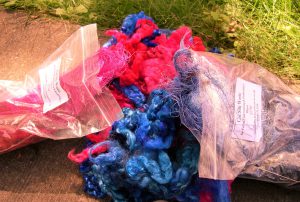 Often, when I teach spinning, I hear a newbie say “Am I doing this right?” or “Am I following the rules?” I usually call the entire class to attention to address this issue. If we focus on human history, we have to acknowledge that as a species, we’d have gotten way too cold (hypothermic even) and died out in the wilderness if there were only one way to spin. Ever since we stopped exclusively wearing animal skins and started producing textiles, folks have been spinning.
Often, when I teach spinning, I hear a newbie say “Am I doing this right?” or “Am I following the rules?” I usually call the entire class to attention to address this issue. If we focus on human history, we have to acknowledge that as a species, we’d have gotten way too cold (hypothermic even) and died out in the wilderness if there were only one way to spin. Ever since we stopped exclusively wearing animal skins and started producing textiles, folks have been spinning.
This may be simplistic, but it’s also important. New spinners — and even experienced ones — need to be open to the idea that there are many good paths to producing useful and even beautiful yarns. Yet, in our rule and habit-bound lives, this can be a hard approach to take. Once you learn how to do something, it’s human nature to repeat it, to seek reassurance through the familiar path to success. That’s why so many spinners have a ‘habit’ yarn. It’s the yarn that we spin, again and again, without trying. It’s thick or thin, even or lumpy, but when we’re unconsciously spinning, it’s our standard. It happens without thinking about it.
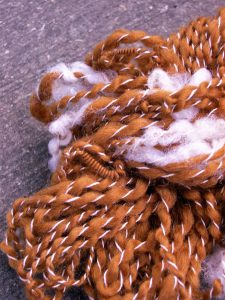 Many of us don’t experiment with something new because it’s risky. We resist experimentation because something might go wrong; we might waste money, time, or fiber. We spent a lot on that hand-dyed 4oz braid of roving; why mess it up? There’s only 10 minutes to spin; why waste it on sampling an art yarn or a lace weight? Or — this prize-winning fleece is only 2 lbs! If I try spinning a variety of yarns, it will all disappear before I’ve made anything!
Many of us don’t experiment with something new because it’s risky. We resist experimentation because something might go wrong; we might waste money, time, or fiber. We spent a lot on that hand-dyed 4oz braid of roving; why mess it up? There’s only 10 minutes to spin; why waste it on sampling an art yarn or a lace weight? Or — this prize-winning fleece is only 2 lbs! If I try spinning a variety of yarns, it will all disappear before I’ve made anything!
These are all legitimate concerns, but one of the reasons why I cherish run of the mill, ordinary medium wools is to avoid feeling like this. I won’t break the bank if I produce 400 yards of super-bulky yarn. I won’t ruin anything if I spin for ten minutes and it doesn’t look exactly the way it looked yesterday. Lastly, if I buy a big Romney fleece from a farmer or 10 lbs of white medium wool roving, there is plenty to spare if my experimentation doesn’t work out.
Don’t get me wrong – I don’t like waste. I try to use every last inch of handspun. However, I have a big stash and I’m not afraid to use it. Recently, my twins showed interest in knitting. We rushed upstairs to my yarn bins to choose their favorite colors. In no time, we were handling yarns, finger knitting, and discussing designs. Each had their own little scrap of “knitting” when we were done. That yarn was not wasted— it inspired future knitters. I felt just the same about the roving and the drop spindles I’d made when they wanted to spin. That yarn, roving and spindles? They were made to be loved, used and enjoyed.
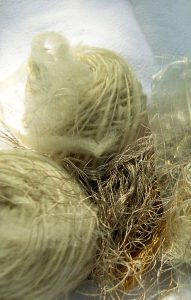 It’s all too easy to ‘over cherish’ our stash. I find myself holding onto that last bit of fleece I got on my honeymoon, a glorious hand-dyed skein I spun, or a bit of luxury fiber so precious that it’s too good to be used. It can be hard to break free of this mindset. Yet, the hand spun qiviut and tussah silk scarf I made for my brother-in-law or the alpaca and silk mitten, scarf and hat set I made a friend are just as cherished now that they are in use, keeping someone warm. Those folks will wear those rare fine fibers out while enjoying their winter woollies. Isn’t that the way it should be?
It’s all too easy to ‘over cherish’ our stash. I find myself holding onto that last bit of fleece I got on my honeymoon, a glorious hand-dyed skein I spun, or a bit of luxury fiber so precious that it’s too good to be used. It can be hard to break free of this mindset. Yet, the hand spun qiviut and tussah silk scarf I made for my brother-in-law or the alpaca and silk mitten, scarf and hat set I made a friend are just as cherished now that they are in use, keeping someone warm. Those folks will wear those rare fine fibers out while enjoying their winter woollies. Isn’t that the way it should be?
Last year, when I knit my twins’ winter mittens, one of my boys insisted that his mitts be handspun, dyed green, with a white stripe, and “that gray Shetland wool from our friend Margaret’s sheep.” Who can resist making handmade mitts for a three year old who appreciates it? I couldn’t. He’s worn them for 7 months (Canadian winters are long!). They show no sign of wearing out. He’ll outgrow them in time to order something exquisite from the stash. I’m waiting to hear what’s next.
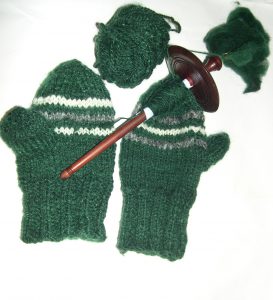 In winter, my preschoolers and I beat back the doldrums of another snowy day by starting a dye pot. We threw in some stained white napkins. Sadly, they were a polyester blend, so while the dye took, the napkins didn’t absorb most of it. I faced throwing out a perfectly good pot full of dye. In the rush to use something –because it’s hard to stash an already half-used pot of dye- I threw in two balls of medium white wool singles that I had handy.
In winter, my preschoolers and I beat back the doldrums of another snowy day by starting a dye pot. We threw in some stained white napkins. Sadly, they were a polyester blend, so while the dye took, the napkins didn’t absorb most of it. I faced throwing out a perfectly good pot full of dye. In the rush to use something –because it’s hard to stash an already half-used pot of dye- I threw in two balls of medium white wool singles that I had handy.
I broke all the rules. I didn’t soak the yarn first. It wasn’t plied. It wasn’t in skeins. It wasn’t a project sized amount. In the end, it didn’t even use up all that dye. No matter.
Sometimes the best indulgence is in allowing myself to break the rules and see what happens. What occurred? Nothing. The yarn didn’t break. The dye took up beautiful and evenly. The strangest things can happen when we allow ourselves to see what will emerge.
Those single skeins of red and purple just might be next year’s mittens, or booties for a friend’s new baby. There’s no telling where these experimental journeys, this delicious chance to create and this indulgence in exploring new fiber might lead.
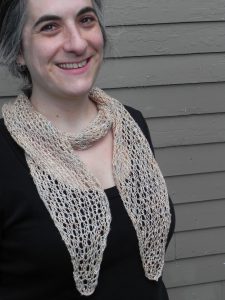 Joanne Seiff is the author of Fiber Gathering and Knit Green. She writes, spins, knits and designs in Winnipeg, Manitoba. Check out her work out on Ravelry—her designs might sing in your hand spun!
Joanne Seiff is the author of Fiber Gathering and Knit Green. She writes, spins, knits and designs in Winnipeg, Manitoba. Check out her work out on Ravelry—her designs might sing in your hand spun!

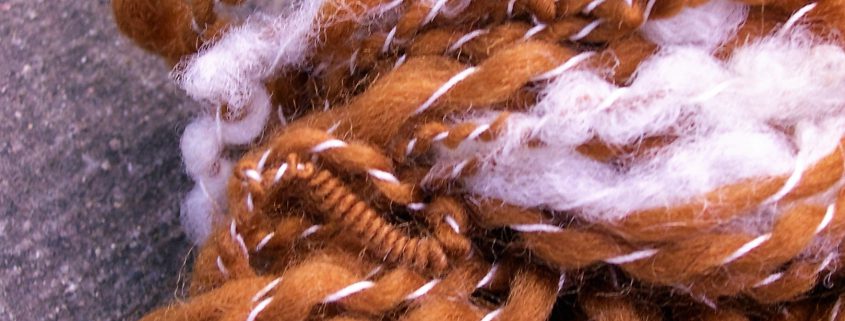



Yes! This is so inspiring, Joanne. I love the adventure of experimentation, asking “what if?” and then finding an answer. I’m loath to do this in most arenas of my life, but spinning is the place where I feel free.
Thanks! Yes, I do feel this is a very freeing idea. So much of our life is fairly self-regulated…after all, we want our children and our careers, etc. to come out well….but spinning yarn? What happens if we experiment and fail? Nothing much aside from the potential waste of valuable materials. So, if we start with less expensive materials, we can learn and experience more,..
Love this! I bought a pile of “felting wool” from an estate sale of a guild member who died suddenly. Was told by the kind volunteers who ran the sale that this was not appropriate for spinning. I played with colors, blending them up on my drum carder and spun glorious tweed yarns. I can’t wait to knit it up. Somehow getting the fiber on the cheap made it easier to play with. And totally worthwhile. Now I’m pulling all kinds of things out of my stash to feed my drum carder. Batt food!
I realized that I’m willing to spend $100 or more to take a class and learn something new, but I’m reluctant to experiment with a few dollars worth of supplies to see what I can do. I’m trying to view my stash as potential learning supplies whether or not it becomes a technically wonderful product. It’s way more fun!